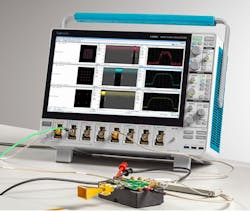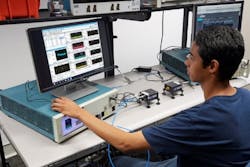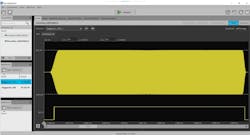Testing Terrestrial and Airborne Electronic-Warfare Apps
What you’ll learn:
- What are the latest scenarios involved in electronic warfare?
- Today’s test challenges and possible solutions.
Electronic warfare (EW) is a fast-evolving technology application that refers to disrupting, degrading, or completely denying an adversary’s situational awareness, communications, and targeting capabilities. EW systems are both terrestrial and airborne, and they increase hand-in-hand with the presence of force power.
Today’s “air power” includes targeting long-range weapons, via autonomous air systems such as unmanned air systems (UAS), as well as using new, complex direction-finding/direction-deceiving radar techniques.
Systems equipped to implement electronic attacks, i.e., disrupt and confuse air defense systems, are essential to achieving EW “supremacy.” But supremacy requires solving complex R&D challenges, and modern test platforms are needed for system validation. In this article, we will briefly cover several advanced use cases where the goal was EW spectrum supremacy to show what test challenges were faced and what methods can be applied to address them.
Key Modern Scenarios in EW
Electronic engineers in aerospace and defense confront a continuous escalation of technology in advanced RF attack and countermeasure electronic protection systems. On one hand, they implement ever-more advanced jamming techniques of enemy electronic infrastructure, and on the other hand, increase the sophistication of protection across a wide span of threats and attacks from hostile forces.
>>Check out the TechXchange for similar articles and videos
In general, EW application scenarios involve advanced radar technologies, electronic countermeasures (ECM) and electronic counter-countermeasures (ECCM), and signal intelligence (SIGINT) gathering. The evolution of EW is now combined with the growing use of controlled unmanned aerial vehicles (UAVs), usually referred to as “military drones.”
In the past, test and measurement suppliers focused on providing RF spectrum-analysis solutions to rapidly and accurately detect signals to identify and track objects. The scenario has evolved in complexity as location and analysis of threats has evolved into a multispectral/multichannel radio-frequency context. At the same time, new semiconductor materials such as gallium-nitride (GaN) semiconductor technology made possible new, lighter, and more cost-effective radar components that increased the capabilities of radar systems.
AESA (airborne electronically scanned array), for example, is a technology for airborne surveillance radar. The antenna consists of an array of transmit/receive modules, each equipped with a small solid-state transmitter and receiver. These modules work together to transmit and receive radar signals in a coordinated and electronically controlled manner, all made possible by advanced processing techniques and sensor-fusion algorithms. As a result, engineers need to conduct AESA more efficiently, safely, and effectively.
Engineers demand test solutions capable of generating complex phase-coherent signals to reproduce the scenarios of phased-array radars, MIMO radar, and other quite complex systems such as Jamming-DRFM radar.
The fastest growing trend in the military radar industry involves MIMO systems. These systems are used for simultaneous transmission and reception by multiple antennas or channels and exhibit radar properties having a low probability of intercepting. Engineers in this area need a compact and cost-effective way to characterize digital RF memory (DRFM) and synchronous, multichannel MIMO systems.
DRFM jammers are essentially transceivers capable of digitizing, recording to memory, modifying, and then retransmitting the recorded waveform. This causes the target radar receiving the modified signal to incorrectly deduce the unit’s speed, bearing, range, or altitude.
A key aspect of these jammers is that they can instantaneously adjust the signal power and frequency using super-fast software-defined systems. Depending on the specific technique that they implement, these jammers may be using range gate pull-off (RGPO), velocity gate pull-off (VGPO), false target generation, etc.
Test Challenges and Possible Solutions
Significant investments in cyber and EW are mirrored by the need to equip laboratories with the latest and most sophisticated test equipment as engineers in A&D request solutions for test-scenario simulation of a full range of radar signals. A typical request is for test equipment that can create multiple pulse groups to form a coherent or non-coherent pulse train, where each pulse group either independently or by adding different pulse groups simulates simultaneous multiple target returns.
Engineers also need to be able to define and generate sequences of “pulse-hopping” patterns in both frequency and amplitude. And each pulse should rapidly and easily configure such pulse parameters as start time, rise time, off time, fall time, pulse width, droop, overshoot, and ripple. On the modulation front, a variety of types such as FM Chirp, QPSK, and BPSK, as well as user-defined custom modulation, is needed.
Certain MIMO radar systems employ time, frequency, or coding techniques in each transmit signal to differentiate them in the receiver element to extract target properties. In this case, engineers need a reliable yet cost-effective solution that offers wide bandwidth, phase-coherent and multichannel analysis.
Addressing these demands, Tektronix offers a broad range of multichannel and wideband oscilloscopes, including 6 Series B MSO, DPO70000SX and MSO/DPO70000DX Series Oscilloscopes. All of these oscilloscopes can be paired with SignalVu vector-signal-analysis (VSA) software.
This VSA software provides multichannel control and analysis with independent settings for parameters such as center frequency, span, and RBW (Fig. 1). The combined software plus hardware system validates a MIMO phased-array radar configured with different center frequencies, time slots, or modulation parameters.
By effectively controlling the segmented memory, SignalVu supports FastFrame mode for capturing only the pulse-on time while disregarding the pulse-off time, thereby facilitating the analysis of hundreds of pulses and preserving the timescale information. An exhaustive pulse statistics display enables engineers to observe time trend and measurement statistics to see how the PRI varies across pulses both over time as well as the absolute delay between channels or time slot.
In the case of modern AESA radars, multiple beams track or focus on multiple targets simultaneously. The signal and its characteristics for each of these beams can be different. Because the Tektronix 6 Series B MSO can have up to eight channels when used together with SignalVu-PC software (Fig. 2), it can support multiple spectral displays for multiple sources. Each source may be assigned to any oscilloscope channel—up to as many as eight—with the span and RBW adjusted for each. The sources can also be either IQ or differential IQ.
New, sophisticated deceptive jamming DRFM-based systems receive and record the frequency, pulse-width, and pulse interval of an enemy system and produce a false return signal by playing back the recorded signal. Engineers can apply Tektronix’s arbitrary waveform generation (AWG) technology to reproduce what DRFM systems can do, i.e., creating, modifying arbitrary waveforms digitally in a precise and fast way.
In fact, these AWGs are fully programmable and can compile and “replay” signals from memory (see an example of staggered PRI pulse waveform in Fig. 3). Because they’re able to create multiple scenarios and assign them to different AWG channels in one compile, users can create up to 50 scenarios made up of individual RF emitter signals and define up to 100 emitters per scenario. Furthermore, these AWGs are tested to meet military vibration standards.
Summary: Dealing with Airborne Electronic Attack
It’s increasingly common for new uncrewed system UASs to carry on-board an advanced radar detection system that’s capable of scanning the RF spectrum to gather data on radar emitters for airborne electronic attack. Such a system can also identify new threats and countermeasures to address them.
Airborne electronic attack involves the disabling, degrading, and denying of enemy air defenses. This can be accomplished through communication interference to deceive opponents by using electronic decoys as well as disrupting enemy threats through jamming their radar and communications systems.




